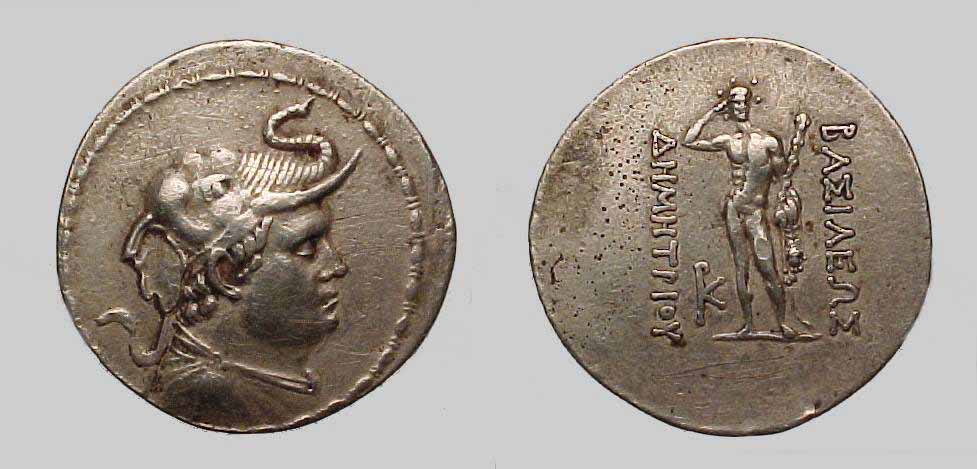

A coin of Demetrios I (r. c.200-180 BCE), who wears an elephant headdress in honor of his Indian conquests
Source: http://www.vcoins.com/realms/store/viewItem.asp?idProduct=343&large=1
(downloaded Mar. 2004)
"Demetrios I, Baktria, c. 200-190 BC. AR - tetradrachm (16.81 g) Draped bust right wearing elephant headdress / Nude herekles standing facing, crowning himself and holding club and lion skin; monogram to left."
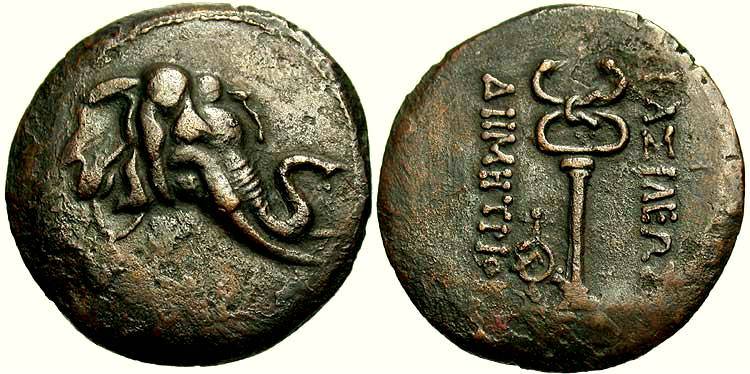
Another example of Demetrios's elephant coins
Source: http://www.vcoins.com/ancient/inclinatioroma/store/viewItem.asp?idProduct=1996&large=0
(downloaded Aug. 2006)
"GREEK KINGS of BAKTRIA: DEMETRIOS I. Circa 200-185 BC. Æ Triple Unit (28.19, 10.4 gm). Head of Indian elephant right, trunk raised, wearing bell / large caduceus, monogram in inner left field, legend to right and left."
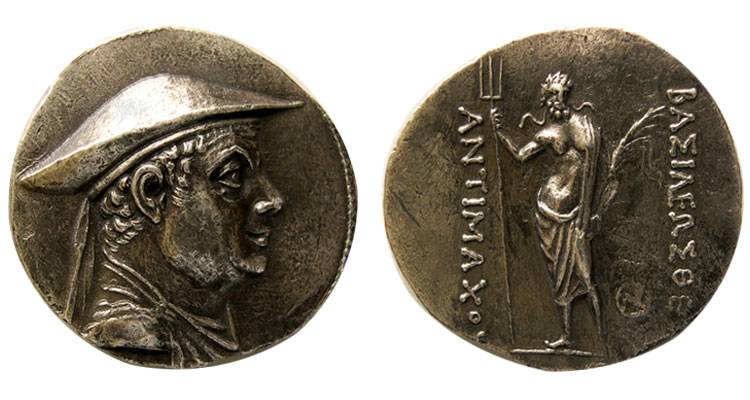
An elegant and entirely Greek coin by Antimachos I (r. c.185-170 BCE)
Source: http://www.vcoins.com/ancient/parscoins/store/viewItem.asp?idProduct=2153&large=1
(downloaded May 2006)
"Antimachus I 174-165 B.C. AR Tetradrachm (16.50 gm; 30 mm). Balkh Mint. Diademed draped bust right wearing kausia / BASILEWS QEOU ANTIMAXOU, Poseidon standing holding trident and palm branch, monogram in field."
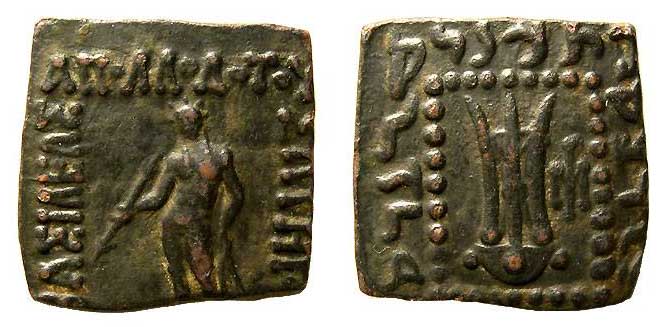
A coin of Apollodotus I (r. c.180-160 BCE); the inscription on the left face is in Greek, and on the right is in the Indic Kharoshthi script
Source: http://www.vcoins.com/ancient/parscoins/store/viewItem.asp?idProduct=2245&large=1
(downloaded May 2006)
"Bactrian Kings: Apollodotos I, 160-150 BC. AE Hemiobol (9.51 gm; 22 mm)."
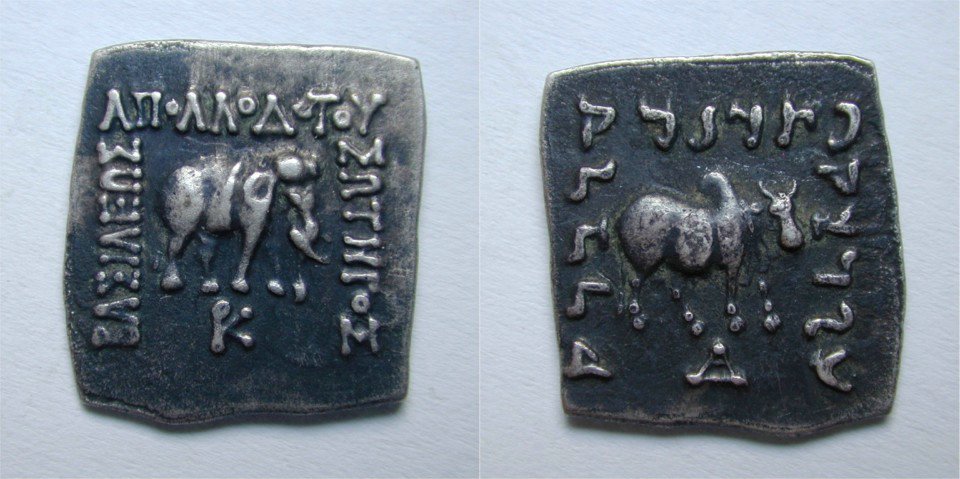
This very Indic square drachma of Apollodotus's features not only Kharoshthi script, but an Indic elephant and zebu as well
Source: http://www.vcoins.com/ancient/mediterraneancoins/store/viewItem.asp?idProduct=2227&large=1
(downloaded Nov. 2006)
"Kings of Baktria Apollodotos C.180/174-165/160, Square AR Drachm (2.40 gm.) . "Basileus Apollodotoi Suthros," Indian elephant standing right, K in exergue / "Maharajasa Apaladatasa Tradarasa" in Karosthi, Zebu bull standing right."
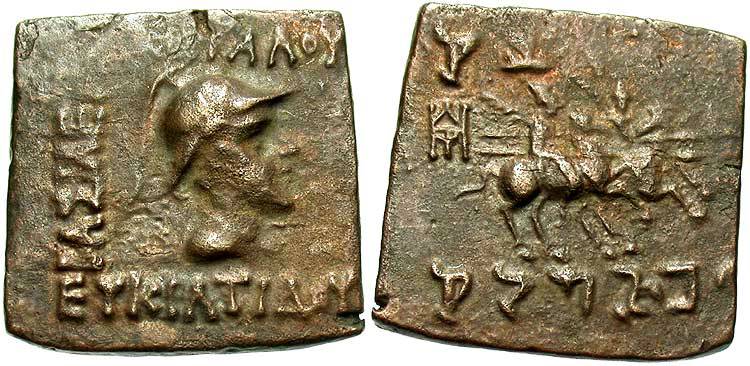
A coin of Eukratides (r. c.170-145) that uses both Greek (left) and the local Kharoshthi script (right)
Source: http://www.vcoins.com/ancient/beastcoins/store/viewItem.asp?idProduct=6279&large=1
(downloaded Oct.. 2006)
"Eukratides, AE Quadruple Unit (Indian Standard), 171-135 BC, Bactrian Kingdom. BASILEWS-MEGALOU-EUKRATIDOU Obv.: Helmeted bust right. Rev.: Karosthi legend above and beneath. The Dioskouroi on horseback prancing right, each holding spear and palm. Monogram | E across fields. 21mm, 8.15g ."
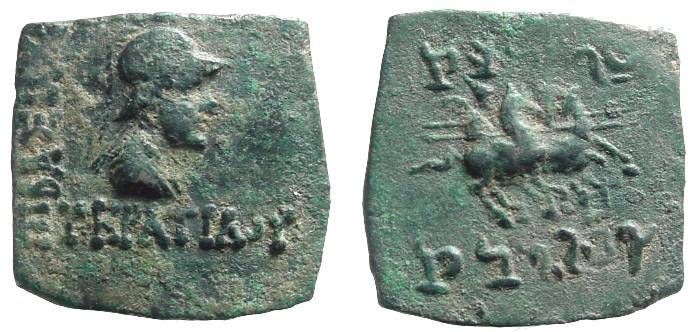
Another example of Eukratides's Greek-and-Kharoshthi coins
Source: http://www.vcoins.com/ancient/sphinx/store/viewItem.asp?idProduct=3410&large=1
(downloaded Apr. 2006)
"Baktria, Eukratides, king of Bactria and India, c.B.C. 171-135; AE(square)
9.42 grms 24 x 25 mm Bust right of the king diad. And helmeted. Rv., the
Dioscuri right, Kharosthi inscription."
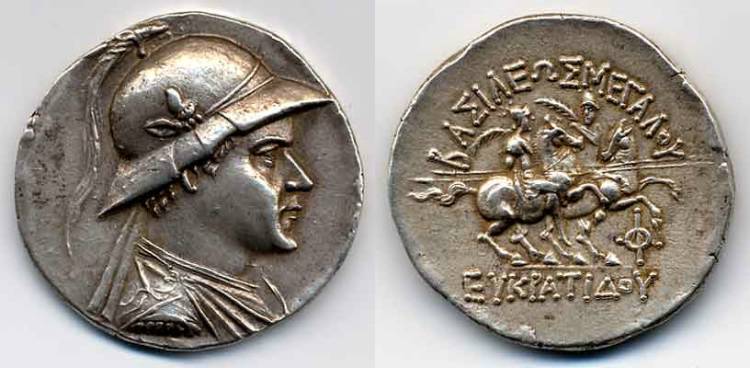
In this gorgeously preserved example, Eukratides emphasizes his Greekness
Source: http://www.vcoins.com/ancient/carsleys/store/viewItem.asp?idProduct=452&large=1
(downloaded May 2006)
"Greek Bactrian Eukratides I, c.171-135 BC. Tetradrachm. O/ Helmeted bust right / the Dioscuri on horseback riding right."
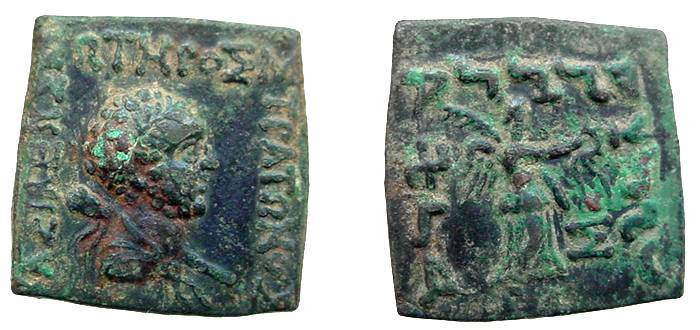
A Greek-Kharoshthi coin minted by Strato I (r. c.120-110 BCE)
Source: http://www.vcoins.com/ancient/sphinx/store/viewItem.asp?idProduct=4002&large=1
(downloaded Oct. 2006)
"Indo-Greek Kings: Strato I 130-110 BC. AE Hemi-obol (7.96 grams). Bust of Herakles right, club over shoulder / Nike walking right, holding wreath and palm; monogram before; control mark sigma = Pushkalavati workshop."
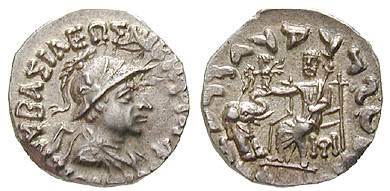
A Greek-Kharoshthi coin of Antialkides (r.c.115-95 BCE), the king whose ambassador erected the famous "Pillar of Heliodorus" near Sanchi
Source: http://www.vcoins.com/ancient/ritter/store/viewItem.asp?idProduct=972&large=1
(downloaded June 2006)
" BAKTRIA AND INDIA, Antialkidas, Drachm. Draped bust r., wearing helmet / Zeus enthroned l., holding Nike, before elephant.."
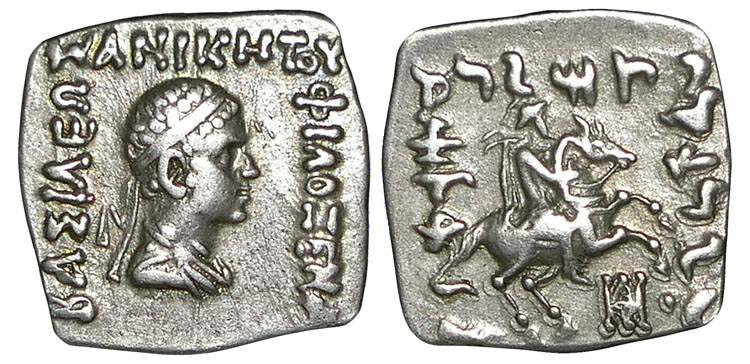
Somewhere along in here came the brief reign of Philoxenos, with his own Greek/Kharoshthi coins
Source: http://www.vcoins.com/ancient/yorkcoins/store/viewitem.asp?idProduct=3302
(downloaded Dec. 2007)
"Indo-Greek Kingdom, Philoxenos (c.100-95 B.C.), Silver Square Drachm, 2.44g., Indian standard; diademed and draped bust right, BASILEWS D NIKHTOU FILOXENOU; rev., helmeted king right on horseback; monogram before."
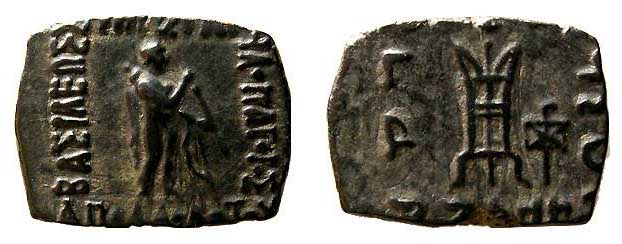
A coin of Apollodotos II (r. c.75-70 BCE) continues the Greek and Kharoshthi combination
Source: http://www.vcoins.com/ancient/parscoins/store/viewItem.asp?idProduct=2373&large=1
(downloaded May 2006)
"Apollodotos II 110-80 BC. AE Dichalkon (3.62 gm; 19 mm). Apollo standing right, holding arrow / Tripod; monogram to left and right. Mint. Taxila."
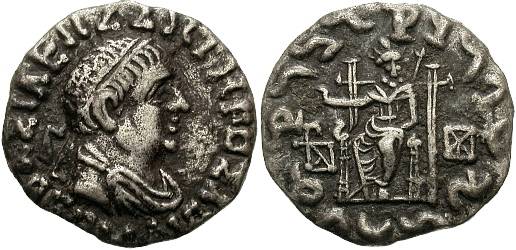
A coin of Hermaios (r.c.40-1 BCE), the last Indo-Greek king, with its Greek and Kharoshthi legends
Source: http://www.vcoins.com/ancient/forumancientcoins/store/viewItem.asp?idProduct=4532&large=1
(downloaded Nov. 2006)
"Indo-Greek Kingdom, Hermaios, c. 40 - 1 B.C. Silver drachm, 1.774g, 16.1mm; obverse BASILEWS EWTHROS ERMAOIU, draped and diademed bust right; reverse, Karosthi legend around, Zeus enthroned slightly left, right hand extended, scepter in left, monograms left and right."
| == INDIAN ROUTES index == sitemap == Glossary == FWP's main page == |